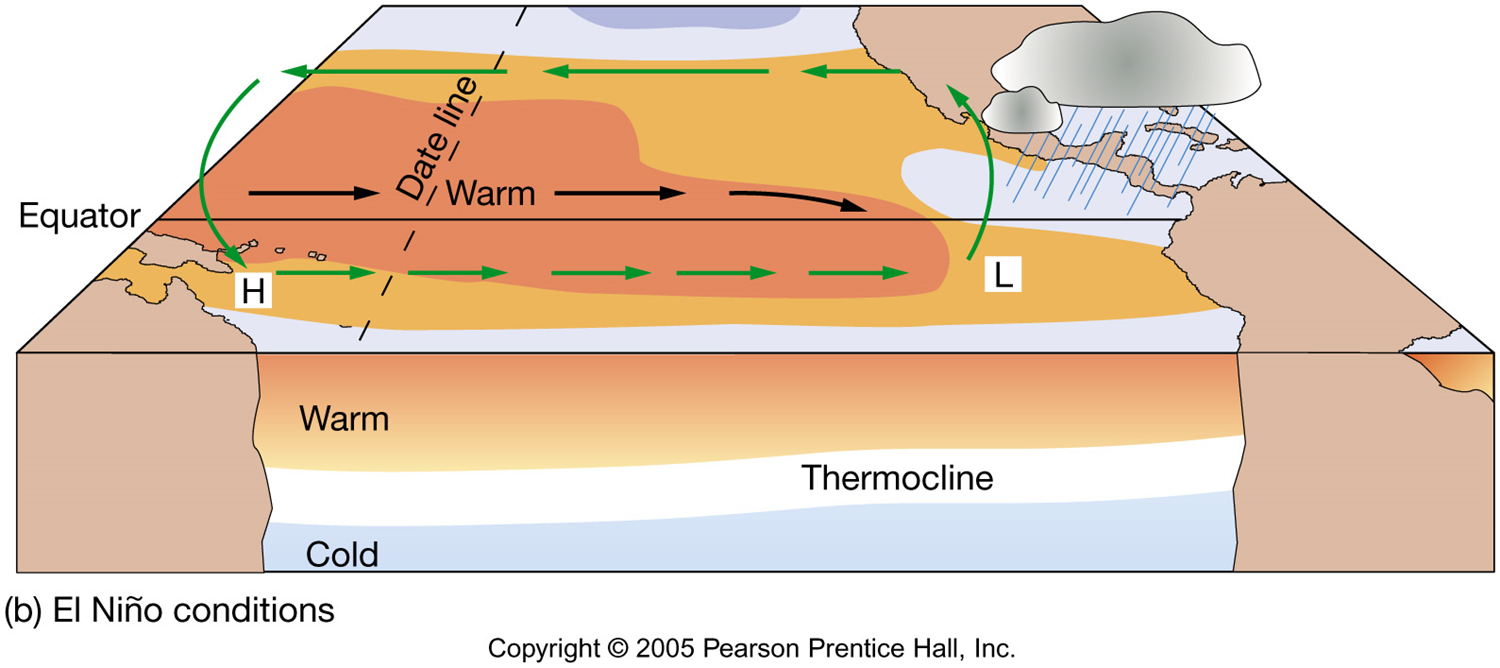El Niño and La Niña
El Niño
Normal conditions in the tropical Pacific Ocean
Surface winds move from east to west and form a high pressure system over S. America and a low pressure system over Australia. This movement of air from high to low pressure in this region is called the Walker Circulation Cell. Surface currents also move water westward, and together with the winds they concentrate the warm water in the western Pacific Ocean.
Western Pacific Ocean
|
Eastern Pacific Ocean
|
 |
|
The ENSO - El Niño-Southern Oscillation
Every 3 – 8 years, the system reverses. Trade winds weaken or reverse and the warm water migrates from Australia to S. America. It arrives in time for Christmas. The people of South America call it the Corriente del Niño, and it's not a nice Christmas present. There are two phases: the Warm (El Niño) and cold (La Niña) phases.
Western Pacific Ocean
|
Eastern Pacific Ocean
|
 |
|
What is El Niño?
Basically, it's a giant puddle (or pod) of heated water that sloshes across the Pacific Ocean. It's similar to an iceberg in that the warm pod extends deep below the surface.
Typically an El Niño event lasts 1 year but can last up to 3 years. In multi-year events, first year not as affected. Even though all of the action occurs in the southern hemispheres, El Niño has effects in both hemispheres.Effects of El Niño - Biology
Upwelling is typical off western S. America and is responsible for the great biologic productivity in the area. However, this reverses to downwelling during El Niño years. Fish, birds, etc. die or migrate away from area. This creates a loss of revenue from fishing, tourism, etc., which adversely affects the local economy.
Effects of El Niño - Oceans
Sea level rises as much as 20 cm (8 in) and the water temp increases up to 7º C in the eastern Pacific Ocean waters off the coast of South America. As the temperature increase, so does evaporation and the intensity of low pressure system. This results in increased rainfall amounts in normally dry areas and intensifies coastal storms
Recognizing an El Niño
Basically, scientists just check the Sea Surface Temperatures (SST). Normal: 6-8° C warmer in the western tropical Pacific than in the eastern tropical Pacific.

La Niña
La Niña is not the opposite of an El Niño. Rather, it is a return to “normal” conditions from an El Niño strong. La Niña produces strong currents, powerful upwelling, and chilly and stormy conditions along S. American coast. The Eastern Pacific cools rapidly, and the Western Pacific warms rapidly. The Trade Winds return to normal and spreads the cooler eastern Pacific waters westward.
Western Pacific Ocean
|
Eastern Pacific Ocean
|
 |
|
Current El Niño Status

From: NOAA Center for Weather and Climate Prediction / Climate Prediction Center
><< back |
||
